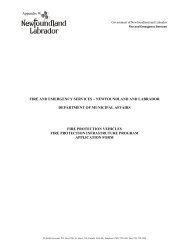Basic Level Pre-Course Reading
Basic Level Pre-Course Reading
Basic Level Pre-Course Reading
Create successful ePaper yourself
Turn your PDF publications into a flip-book with our unique Google optimized e-Paper software.
Chapter 3<br />
CBRN Assessment and Incident Recognition<br />
3.2.3 Radiological/Nuclear Agents (Materials)<br />
Radiation can be divided into two general categories: ionizing and nonionizing.<br />
Non-ionizing Radiation is radiation such as Ultraviolet (UV) rays, microwaves,<br />
lasers, and electromagnetic fields (EMFs) from electric power lines. Although<br />
there are some health hazards associated with certain types and levels of nonionizing<br />
radiation, the hazards are generally small.<br />
Ionizing Radiation is radiation that may cause damage to the human body by<br />
interacting with cells. It is this type of radiation that is dealt with in this course<br />
and unless otherwise specified, references to “radiation” should be taken to<br />
mean ionizing radiation. There are four major types of ionizing radiation.<br />
• Alpha Particles are large atomic particles. They have little external<br />
penetrating power, but can be harmful if alpha particle emitting radioactive<br />
material enters the respiratory tract, is swallowed or enters through an open<br />
wound. A typical alpha particle will travel no more than a few centimetres in<br />
air and can be stopped by the outer layer of skin or a sheet of paper.<br />
• Beta Particles are small atomic particles (electrons) that are fast moving<br />
and have limited penetrating ability. They can be harmful if beta particles<br />
emitting radioactive material enters the respiratory tract, is swallowed or<br />
enters through an open wound. A typical beta particle can travel up to<br />
several metres in the air and is stopped by skin, thin layers of wood or<br />
plastic.<br />
• Gamma Radiation and X-Rays are electromagnetic waves. Gamma<br />
radiation and X-Rays are capable of penetrating all parts of the body and<br />
can actually pass right through the body. These “waves” can travel several<br />
metres in air and may be shielded by using concrete, steel, lead, or other<br />
dense materials.<br />
• Neutrons are particles that have been emitted from an atom’s nucleus and<br />
are capable of penetrating all parts of the body. They are normally<br />
associated with the operation of nuclear power plants and nuclear weapons.<br />
Neutrons can travel long distances and may be shielded by using materials<br />
such as wax, water, or concrete.<br />
Radiological or radioactive materials emit ionizing radiation. Ionizing radiation is<br />
energy in the form of electromagnetic waves (like x-rays) or sub-atomic particles.<br />
This type of radiation cannot be seen, heard, felt, smelled, or tasted.<br />
Radiation is everywhere in the natural environment. It comes from the sun, outer<br />
space, soil and rocks, the air, and even from within the body. Everyone is<br />
exposed to this natural “background” radiation every day.<br />
CBRN First Responder Training Program<br />
24<br />
<strong>Basic</strong> <strong>Level</strong> <strong>Course</strong>

















